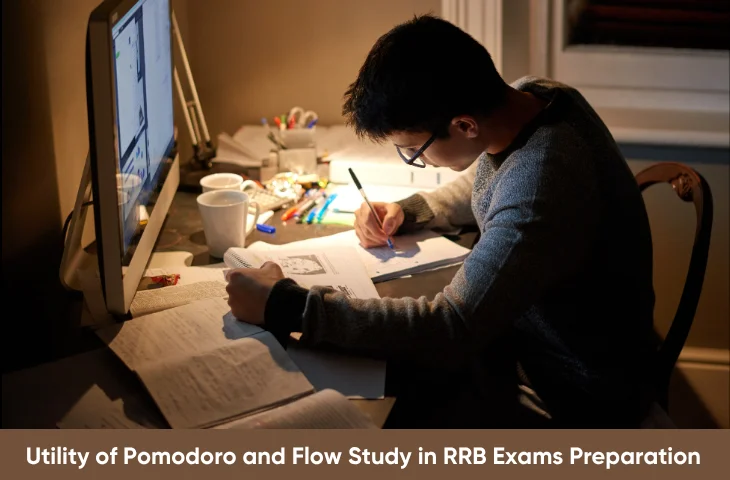Preparing for RRB exams requires not just knowledge of the syllabus but also a smart approach to studying. Many aspirants complain about poor concentration, low productivity, and lack of consistency. That’s where study methods like Pomodoro and Flow come into play. Both are effective but work differently depending on your personality, energy levels, and the stage of preparation.
In this article, we’ll explore the differences, benefits, and limitations of both methods, and help you decide which one suits your RRB Exams Preparation journey in 2025.
Understanding the Two Study Methods for RRB Exams
Both Pomodoro and Flow Study Method are important for RRB Exams. Some of the key differences between the two are given below:
What is the Pomodoro Technique?
- The Pomodoro Technique breaks study time into 25-minute focused sessions, followed by a 5-minute short break.
- After 4 Pomodoros, you take a longer break of 15–30 minutes.
- It emphasizes short bursts of concentration, ideal for repetitive tasks or when you struggle to stay focused.
What is the Flow Study Method?
- The Flow Method is about entering a deep state of concentration, where you lose track of time and immerse yourself in the subject.
- Study sessions can last 1–3 hours without a break if you’re fully absorbed.
- It is best for conceptual clarity, problem-solving, and handling complex topics.
Why Study Methods Matter in RRB Exams Preparation
The RRB exams (NTPC, ALP, Technician, Group D, and JE) require balancing different sections Mathematics, Reasoning, General Awareness, Science, and Trade/Technical topics. Some parts need long, uninterrupted focus (like solving advanced math problems), while others need short, repeated practice (like memorizing current affairs). Choosing the right study method can:
- Prevent burnout
- Improve retention
- Enhance exam performance
- Save precious preparation time
Comparing Pomodoro and Flow for RRB Exams
A detailed comparison table has been given below between Pomodoro and Flow Method for the applicants. Check out the details:
| Aspect | Pomodoro Method | Flow Study Method |
| Productivity & Focus | Great for aspirants who get distracted easily or use mobile phones frequently. The timer keeps you accountable. | Ideal for aspirants who can sit for longer hours and dive deep into subjects like Physics, Electrical Circuits, or Advanced Math. |
| Retention & Recall | Works well for factual learning — GK, current affairs, formulas, and revision. | Works better for analytical learning — reasoning puzzles, technical diagrams, long problem-solving. |
| Flexibility | Fixed time slots may feel restrictive if you’re on a roll. | Flexible and natural, but risky if you forget to take breaks (leading to fatigue). |
When to Use Pomodoro in RRB Exams Preparation?
It is very important to know the correct time to use Pomodoro in exams such as RRB NTPC, ALP, Technician, and more.
- During Early Preparation: When building habits and consistency.
- For Memorization Tasks: Learning GA facts, formulas, abbreviations, and computer basics.
- For Short Study Windows: Useful if you have only 1–2 hours daily due to work or college.
- To Beat Procrastination: Starting with just 25 minutes feels less overwhelming.
Example: If you need to memorize 50 static GK facts, split them into 2–3 Pomodoros and review at the end of the day.
When to Use Flow in RRB Exams Preparation?
The correct time to use flow method in RRB Exams Preparation are given below:
- During Advanced Preparation: When you’re solving mock tests or analyzing performance.
- For Conceptual Subjects: Electrical Machines, Thermodynamics, Advanced Reasoning puzzles.
- When You’re in “The Zone”: If you’re naturally focused and can study for hours without distractions.
- For Revision in Bulk: Covering multiple chapters in one stretch during last weeks before the exam.
Example: Sitting for 2.5 hours straight to solve a complete RRB Technician previous year paper.
Hybrid Strategy: The Best of Both Worlds
Most aspirants find that using both methods strategically works best:
- Use Pomodoro for memory-heavy tasks in the morning (GK, formulas).
- Use Flow for deep problem-solving sessions in the afternoon/evening.
- Alternate between the two depending on energy levels.
Tips to Maximize Each Method
Given below are some tips to maximize each method:
| Method | Tip for Effective Use |
| Pomodoro | Use a mobile timer or apps like Focus To-Do. During breaks, stretch or drink water instead of scrolling social media. Gradually increase session length (25 → 40 minutes) if you get comfortable. |
| Flow | Eliminate distractions (switch off notifications, use a quiet space). Keep a notepad handy for doubts and avoid breaking concentration. Set an upper limit (2–3 hours) to prevent mental fatigue. |
Key Points
To sum up the article, we have provided some key points. Check out the details below:
- Pomodoro = Best for memorization, revision, and beginners struggling with focus.
- Flow = Best for deep understanding, problem-solving, and advanced prep stages.
- RRB Exams Preparation requires both short sprints (Pomodoro) and long runs (Flow).
- A hybrid method ensures consistency, depth, and balance.
- Always adapt study methods based on your energy, time availability, and exam phase.
When it comes to RRB Exams Preparation, there is no one-size-fits-all solution. The Pomodoro Technique keeps you disciplined and consistent, while the Flow Method helps you unlock peak productivity for complex subjects. The real secret is knowing when to use which method. By blending Pomodoro for quick drills and Flow for deep sessions, you’ll cover the syllabus more effectively, retain knowledge longer, and walk into the exam hall with confidence.
FAQs
The Pomodoro technique involves studying in short intervals (usually 25 minutes) followed by a 5-minute break. This helps maintain focus, avoid burnout, and improve retention, making it highly effective for long study hours needed in RRB exam prep.
While Pomodoro relies on fixed time blocks, the Flow method emphasizes getting deeply immersed in one task for an extended period without distractions. It is useful for subjects that require problem-solving and deep conceptual understanding in RRB exams.
Both methods have unique benefits. Pomodoro is better for building consistency and avoiding fatigue, while Flow is more suitable when tackling lengthy reasoning problems or technical subjects. A balanced mix of both is often the best approach.
Yes. You can start with Pomodoro to build a study habit and gradually switch to Flow sessions when you feel deeply engaged in a topic. Combining both methods helps in balancing productivity with deep focus.
Ideally, 8–10 Pomodoro sessions (about 4–5 hours of focused study) per day is effective. You can increase or decrease sessions depending on your preparation stage, stamina, and ability to maintain focus.

Hello! This is Arijit Dutta. I am a skilled Content Writer at Oliveboard with nearly 3+ years of experience in crafting engaging, informative, and exam-focused content for the Railways Domain. With a strong command of language and a keen understanding of learner needs, I contribute significantly to Oliveboard’s mission of delivering high-quality educational resources. Passionate about clear communication and continuous learning, I consistently create content that helps government job aspirants achieve their goals. Outside of work, I enjoy playing cricket and listening to music, which helps me stay balanced and creative in my professional journey.
